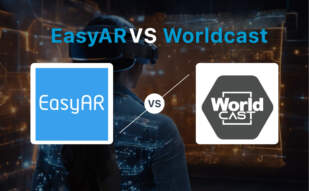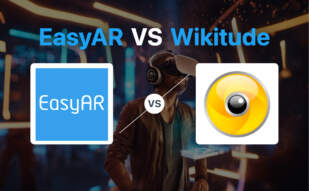When it comes to AR application development, EasyAR excels with platform versatility and advanced features such as 3D physical world models. However, its pricing might be burdensome for some. Alternatively, Onirix shines with its user-friendly AR content creation and web compatibility, despite a potentially steep price point for small entities and lack of a ‘pay as you go’ model.

Key Differences Between EasyAR and Onirix
- Platform Capabilities: EasyAR provides cross-platform support, advanced AR features, and specializes in connecting underlying technology, AR software with downstream applications. Onirix offers a simpler, more intuitive platform mainly for AR content creation and immediate Web AR access.
- Target Users: EasyAR is geared toward developers while Onirix targets developers and professionals who prefer a non-technical user-interface.
- Pricing: EasyAR costs $39/month with a free trial; Onirix starts at €89 per month, also offering a free version and trial.
- Key offerings: EasyAR’s SenseMARS provides AI-enabled AR/MR content generation while Onirix is praised for its ease in creating and publishing multimedia AR content.
| Comparison | EasyAR | Onirix Studio |
|---|---|---|
| AR platform | AR application development platform | AR content creation and publishing service. |
| Software features | Relocalization, persistent AR content, local, cloud-based, AR configurator, AR measurement. | User interaction, transition between elements, WebAR player, Experience Editor, Geolocated maps. |
| SDK & integrations | EasyAR SDK, API access for integration. | Unity SDK for iOS device permission management. |
| Content types | AR app development, 3D physical world models, digital identity avatar. | 3D models, videos, interactive elements. |
| Pricing | Pricing at $39/month, free trial. | From €89 per month, free version and trial available. |
| Pros & cons | Pros: cross-platform support, easy integration, accurate AR features. Cons: Unfeasible pricing, lack of optimization, limited web support. | Pros: simplicity, power, fair pricing, distinctive features. Cons: steep price, no ‘pay as you go’ license model for paused projects. |
| Founded | 2012, China | Spain |
| Target audience | Underlying tech, AR software with downstream applications. | Developers, professionals. |
What Is EasyAR and Who’s It For?
EasyAR, originating from China in 2012, is an influential Advanced Reality (AR) platform designed for application development and digital animations. Offering functionalities powered by its software platform, SenseMARS, and version 4.0 of EasyAR Sense, it’s ideal for developers looking to implement AR applications across iOS, Android, Windows, and macOS platforms. Anyone looking to auto-generate digital identity in the Metaverse or aiming to create AR more efficiently will find EasyAR both powerful and versatile.

Pros of EasyAR
- Cross-Platform Support
- Offers Easy Integration
- Accurate AR Features
- Avatar Auto-generated from Photos
- No Coding Necessary for AR App Development
Cons of EasyAR
- Unfeasible Pricing for Some Users
- Lack of Optimization
- Limited Web Support
“
What Is Onirix and Who’s It For?
Onirix Studio, based in Spain, provides an efficient and interactive platform for AR content creation and publishing. With the incorporation of various interactive elements like 3D models, audio files, videos and its WebAR player, Onirix caters to a diverse range of sectors including nonprofits, IT services, graphic design, software firms and program development. Its intuitive platform is a go-to choice for developers and professionals seeking to improve AR service User Experience (UX).

Pros of Onirix
- Powerful, Simple AR content Creation
- Interactive Element Integration
- Content Sharing Across Digital Platforms
- Direct AR Visualization in Web Browser
- No App Required
Cons of Onirix
- High Pricing for Smaller Companies
- No ‘Pay as You Go’ License Model
EasyAR vs. Onirix – Which One Suits You Best?
Choose your champion between EasyAR and Onirix based on your technological requirements, project scope, and budget.
Game Developers & AR/VR Creators
EasyAR, with its powerful SDK and support across platforms including iOS, Android, Windows, and macOS, provides a ripe playground for creativity and innovation. The no-code requirement expedites AR app development significantly. However, the unfeasible pricing and lack of optimization might be barriers.
Professionals in Retail, Education, Repair & Maintenance, and Medical Industries
Incorporating AR into operations can transform experiences. While EasyAR opens up vast possibilities with its AR CMS, AR SDK, AR WYSIWYG editor software, and other types of AR software, Onirix’s direct AR visualization inside the web browser is potentially the more lean and efficient choice. The instant interaction enabled by Onirix can be very valuable.
For the Budget-Conscious
If pricing is your biggest concern, Onirix’s free version and trial make it a valuable contender. EasyAR, though priced at $39/month, offers a free trial, within which you can assess if the offerings justify the cost.
Agencies, Travel, Retail, and Restaurants
Regardless of your agency type or your role in the tourism, retail, or restaurant sector, Onirix, with its focus on Web AR, offers an effective AR solution without the requirement of an app. Coupled with an intuitive platform, the non-technical user experience can be significantly improved.
If you seek expansive support across platforms, while not restricting coding experience, EasyAR is your champion. For those craving web-based AR content sharing and interaction, without the requirement of an app, Onirix is your wise choice.
Logan Bellbrook
Content writer @ Aircada with a knack for nature & AR/VR/XR. Blogging the intersection of tech & terrain.





